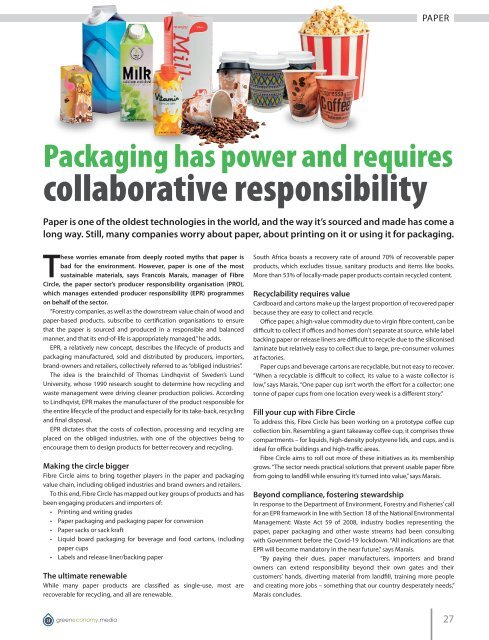Green Economy Journal Issue 41
You also want an ePaper? Increase the reach of your titles
YUMPU automatically turns print PDFs into web optimized ePapers that Google loves.
PAPER<br />
Packaging has power and requires<br />
collaborative responsibility<br />
Paper is one of the oldest technologies in the world, and the way it’s sourced and made has come a<br />
long way. Still, many companies worry about paper, about printing on it or using it for packaging.<br />
These worries emanate from deeply rooted myths that paper is<br />
bad for the environment. However, paper is one of the most<br />
sustainable materials, says Francois Marais, manager of Fibre<br />
Circle, the paper sector’s producer responsibility organisation (PRO),<br />
which manages extended producer responsibility (EPR) programmes<br />
on behalf of the sector.<br />
“Forestry companies, as well as the downstream value chain of wood and<br />
paper-based products, subscribe to certification organisations to ensure<br />
that the paper is sourced and produced in a responsible and balanced<br />
manner, and that its end-of-life is appropriately managed,” he adds.<br />
EPR, a relatively new concept, describes the lifecycle of products and<br />
packaging manufactured, sold and distributed by producers, importers,<br />
brand-owners and retailers, collectively referred to as “obliged industries”.<br />
The idea is the brainchild of Thomas Lindhqvist of Sweden’s Lund<br />
University, whose 1990 research sought to determine how recycling and<br />
waste management were driving cleaner production policies. According<br />
to Lindhqvist, EPR makes the manufacturer of the product responsible for<br />
the entire lifecycle of the product and especially for its take-back, recycling<br />
and final disposal.<br />
EPR dictates that the costs of collection, processing and recycling are<br />
placed on the obliged industries, with one of the objectives being to<br />
encourage them to design products for better recovery and recycling.<br />
Making the circle bigger<br />
Fibre Circle aims to bring together players in the paper and packaging<br />
value chain, including obliged industries and brand owners and retailers.<br />
To this end, Fibre Circle has mapped out key groups of products and has<br />
been engaging producers and importers of:<br />
• Printing and writing grades<br />
• Paper packaging and packaging paper for conversion<br />
• Paper sacks or sack kraft<br />
• Liquid board packaging for beverage and food cartons, including<br />
paper cups<br />
• Labels and release liner/backing paper<br />
The ultimate renewable<br />
While many paper products are classified as single-use, most are<br />
recoverable for recycling, and all are renewable.<br />
South Africa boasts a recovery rate of around 70% of recoverable paper<br />
products, which excludes tissue, sanitary products and items like books.<br />
More than 53% of locally-made paper products contain recycled content.<br />
Recyclability requires value<br />
Cardboard and cartons make up the largest proportion of recovered paper<br />
because they are easy to collect and recycle.<br />
Office paper, a high-value commodity due to virgin fibre content, can be<br />
difficult to collect if offices and homes don’t separate at source, while label<br />
backing paper or release liners are difficult to recycle due to the siliconised<br />
laminate but relatively easy to collect due to large, pre-consumer volumes<br />
at factories.<br />
Paper cups and beverage cartons are recyclable, but not easy to recover.<br />
“When a recyclable is difficult to collect, its value to a waste collector is<br />
low,” says Marais. “One paper cup isn’t worth the effort for a collector; one<br />
tonne of paper cups from one location every week is a different story.”<br />
Fill your cup with Fibre Circle<br />
To address this, Fibre Circle has been working on a prototype coffee cup<br />
collection bin. Resembling a giant takeaway coffee cup, it comprises three<br />
compartments – for liquids, high-density polystyrene lids, and cups, and is<br />
ideal for office buildings and high-traffic areas.<br />
Fibre Circle aims to roll out more of these initiatives as its membership<br />
grows. “The sector needs practical solutions that prevent usable paper fibre<br />
from going to landfill while ensuring it’s turned into value,” says Marais.<br />
Beyond compliance, fostering stewardship<br />
In response to the Department of Environment, Forestry and Fisheries’ call<br />
for an EPR framework in line with Section 18 of the National Environmental<br />
Management: Waste Act 59 of 2008, industry bodies representing the<br />
paper, paper packaging and other waste streams had been consulting<br />
with Government before the Covid-19 lockdown. “All indications are that<br />
EPR will become mandatory in the near future,” says Marais.<br />
“By paying their dues, paper manufacturers, importers and brand<br />
owners can extend responsibility beyond their own gates and their<br />
customers’ hands, diverting material from landfill, training more people<br />
and creating more jobs – something that our country desperately needs,”<br />
Marais concludes.<br />
greeneconomy.media<br />
27


















